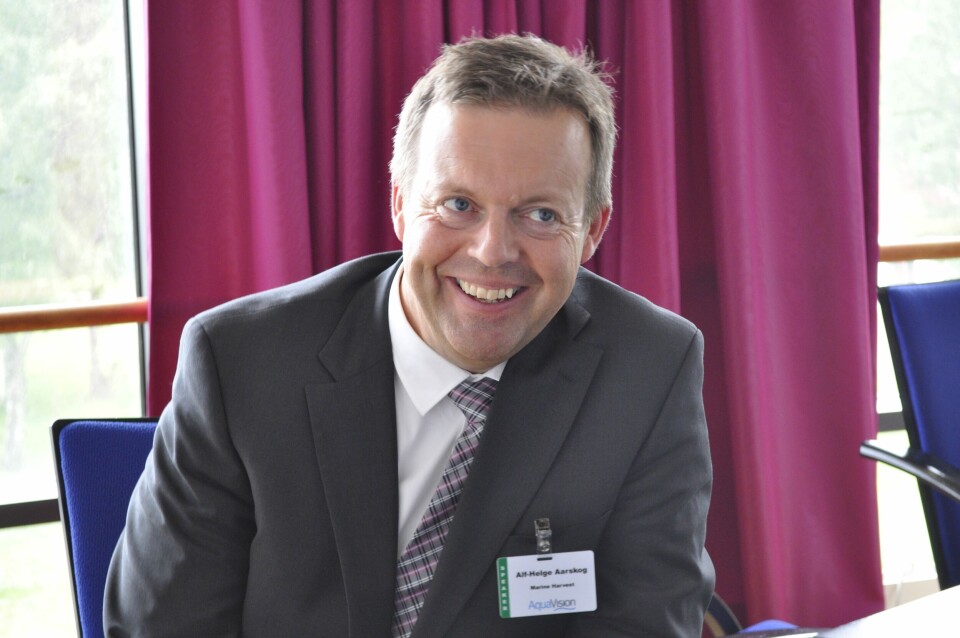
Lice and costs must be reduced
Too much money was spent on fighting sea lice during 2016, according to Marine Harvest’s CEO, Alf Helge Aarskog.
“In 2017 its necessary to work even harder and smarter to come up with solutions that can reduce both sea lice and costs,” he told kyst.no, when asked to sum up the year and outlined the company's ambitions for 2017.
Despite this, Aarskog thinks 2016 has been a good year for Marine Harvest.
“The employees of the company worldwide have made an impressive effort, allowing us to achieve record results in several quarters,” he said.
Aarskog points out that there have been several important milestones for the company this year, not least the decision to built a feed plant in Scotland.
“We are convinced that this will cut costs and ensure better controls. Most recently we have, if all the paperwork is in order, established ourselves on the east coast of Canada. I think it can be a great advantage for us to have operations as close market on the US East Coast. In addition, we see finally some movement in terms of applications for development concessions,” he says.
He notes that MH Chile has also undergone a major turnaround.
“After some difficult years and a demanding process, in the third quarter we finally started to make a profit in Chile,” says the CEO.
Increasing production
Other than lice, Aarskog says that the greatest challenges in the industry has been to produce enough fish.
“Lice are the industry's biggest challenge and are likely to remain so in the coming years. Like the rest of the industry, it has been difficult for us to produce more fish this year than previously. Algal blooms in February and March were a heavy blow for our operations in Chile. We lost a total of three million salmon, which we obviously would rather have sent to our customers,” he explains.
Aarskog says that the single most important event in the industry in 2016 was the normalization of diplomatic relations between Norway and China.
“We hope this and will normalize trade relations, and Marine Harvest is ready to take advantage of it. We're probably the only company that has a sales force on the ground, which can now look forward to selling Norwegian salmon again,” he adds.
Traffic light system
Aarskog thinks it's too early to say how the traffic light system the Norwegian Fisheries Ministry will initiate in early 2017 will affect production.
“Marine Harvest has been clear that major growth will not occur until they are rid of the lice. It's also true that the minister has allowed for growth in areas where the lice situation is good. We have been granted growth of concessions in the Kvænangen and Flekkefjord, where we together have paid NOK 11 million to municipalities,” he reflects.
Shipping schemes
In 2016 Marine Harvest became co-owner of wellboat company DESS Aquaculture Shipping – a 50-50 joint venture with Deep Sea Supply, which came about after Marine Harvest said they would build their own wellboat company and own fleet of workboats instead of renting – and the CEO has great faith in the company.
“We have great expectations that this company can help to reduce costs for industry and Marine Harvest,” he says.
According to the CEO of DESS Aquaculture Shipping, Jon Are Gummedal, Marine Harvest spends around 100 million euros annually to rent wellboats, using around 44 vessels each year.
They will, however continue to rent a large number of vessels as they build up their own capacity.
“We will still hire from the cheapest and best suppliers,” Aarskog concludes.
Kyst.no have previously written that the new company is due to be handed its first wellboat in the third quarter of 2017. This will serve in Canada, and the company has an option for a further three vessels each with a capacity of 3,000m3. It also engaged in the design process of a processing vessel.























































